Cereals without gluten and simple recipes with them
 Bashny.Net
Bashny.Net
In our market, in the shops of "healthy nutrition" there are all new products, including cereals. Which of them can (and should) use to patients with celiac disease and which are not?
The answers in the table and the magazine "Deli" № 2 (73) for February 2008
A doctor's note Artemova E. M.: a categorical ban on these products only applies to celiacs. As for patients with coeliac and just people wanting to lead a healthy and comfortable lifestyle, in cases where the product is over a little gluten for this category of people for example, it is highlighted in green. In addition, patients with celiac disease should take into account the presence of gluten in the germ of corn kernels. This, incidentally, implies the prohibition for these patients, "pshonka" – boiled cobs, whole corn, canned corn, corn flour, non-industrial production. In the industrial production of corn flour from the grain during milling removes the germ!
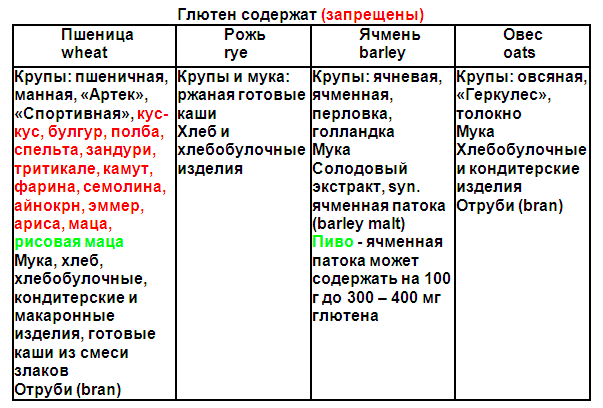
Not contain gluten (allowed):
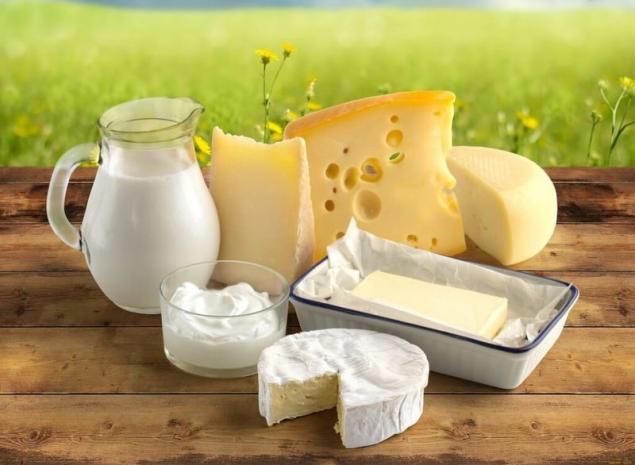
Buckwheat , a close relative of rhubarb and sorrel. This herbaceous plant comes from the mountainous regions of India, Burma and Nepal where he began to cultivate more than four thousand years ago. From India "black rice" came to China, Central Asia, Africa, the Caucasus and Greece. In Kievan Rus it was engaged in breeding of Greek monks. It's probably why she started calling it "Greek" barley. In addition to the common buckwheat there is another wild species of this plant, common in Siberia and the Urals region – Tatar buckwheat (Fagopyrum tataricum). In Ukraine and in the Volga region it is called "Tartar".
In southern Russian, Ukrainian and Western regions of the buckwheat is sometimes called a "drop cap" for the similarity of its seeds with seeds of beech. Boekweite Dutch, German buchweizen buckwheat and English the name also translated as "beech wheat". French (ble sarassin) and Italian (grano saraceno) – Aracinovo grain is most closely related to the dark color of the beans.
Buckwheat porridge with white mushrooms
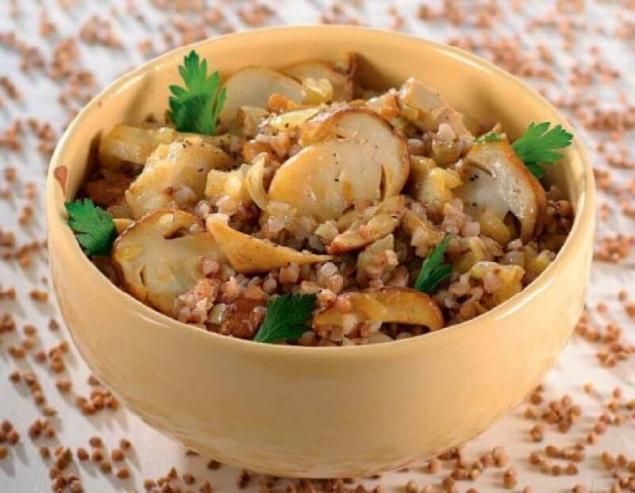
Clean the mushrooms with a brush, not defrosting, pour 1 liter of boiling water, bring to the boil, add salt, cook for 10 minutes. drain in a colander (save the broth), dry.
Lightly fried buckwheat with thyme and salt in 1 tbsp oil, pour the hot broth from the mushrooms, cook under the lid, not stirring, until all the liquid is absorbed, 12 – 15 min.
Wrap the pot in Newspapers and blankets for 15 min.
Onion cut into thin rings and fry in 3 tbsp oil on low heat until Golden brown, 15 min.
In another pan in the remaining oil over high heat, quickly fry the mushrooms. Spread out on warmed plates cereal, sprinkle onions and mushrooms, serve immediately.
Millet (millet) is the oldest cultivated plant known to the Asians and Africans for over 5 thousand years and is still the staple food of one third of the world's population. At the same time in the United States and Western Europe, millet is used mainly as feed for livestock and poultry. But in recent years, in connection with a widespread fascination healthy diet, this rich in protein and carbohydrates grass begins to enter into the daily diet of Europeans and Americans, who call him the Russian word proso.
From millet get several types of cereals: millet-dranec, i.e. whole grains, released from the flower films. This cereal has an intense yellow color, characteristic luster and a bitter taste. Peas (crushed) contains only the grain kernel has been completely cleared. It is lighter than millet-dranec, and not shiny. This millet is better absorbed, cooks faster and is perfect for cereals and casseroles. And finally – millet crushed. This is a byproduct of the processing of the millet, namely, fragmented nucleus.
Millet is boiled as a side dish, stewed with meat, millet flour used to bake bread. Kazakhs love "Nauryz-skin" – Pshenko, fermented in katuke. Ukrainians prefer gruel – liquid millet porridge with bacon, sunflower oil, bacon, onion, garlic, herbs. In the Caucasus until the early twentieth century the main food was a steep millet porridge – "Basta".
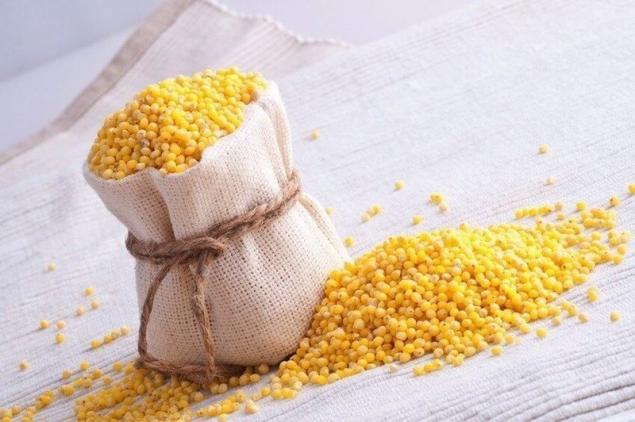
Garlic croutons buckwheat porridge
Crush the garlic. Millet rinse thoroughly. Broth bring to a boil in a saucepan with a thick bottom. Add all ingredients except eggs and cook, stirring, until the mixture begins to fall from the walls.
Shift it in a round neprikosaemye baking dish with a diameter of 23 cm, spatula and cool.
Cut into triangles. Spread on large baking sheet, brush with scrambled egg and bake under the hot grill until they become Golden and crispy.
Serve hot with a green salad, vegetables, sauteed mushrooms.
Amaranth. Worldwide in warm and temperate areas grows Amarant, or amaranth, is used in ornamental horticulture. And in Central and South America thousands of years diluted his grain (or rather, seed). In pre-Columbian era, amaranth was a staple of the indigenous peoples of Mexico, tons of its tiny seeds annually sent to the capital as a tribute to the Supreme ruler.
In the 1950s, when scientists proved the extraordinary nutritional properties of amaranth, the farmers of the southern, Central and even North America again "started" for forgotten grain.
The protein in amaranth as much as in other cereals. It is very rich in lysine – essential for humans amino acid, is not always found in sufficient quantity.
Yellowish-brown, with a slight peppery taste of amaranth grain are usually cooked as porridge or do them in the flour. Grits seasoned broth served on the side. In Mexico, from the seeds, mixed with honey, make a kind of sweet pop corn and Chile fermented seeds give the "beer" – chichi.
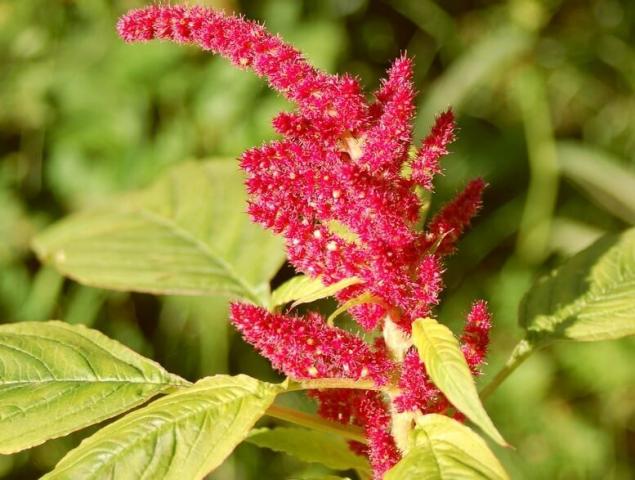
Soup with amaranth
Amaranth cover with cold water, bring to boil, boil 10 minutes, drain in a sieve.
The onion and crush the garlic. Peel the potatoes peeled, the tomatoes and peppers from seeds, cut into cubes.
Fry in oil onion and garlic, 5 min, pour the broth, add the vegetables and cook under the lid 5 min. Add the amaranth and cook for 8 min. Add chopped parsley and spinach, cook for 1 min.
Quinoa. In the Andes, quinoa (quinoa, quinoa, rice quinoa) has been prized since ancient times, Indians considered it a sacred grain, "mother of all grains". This is the highest cereal crop in South America still plays a very important role in the cuisine of Peru, Chile, Bolivia, Ecuador, Colombia.
From nutritious black, white or red flat seeds quinoa which contain large amounts of vitamins, protein and amino acids, which are flour and cereals. They make cakes, cook porridge and even brew beer.
Pre-grain is well washed and soaked, since its surface layer contains bitter substances. Grains sold in supermarkets, have already passed this procedure.
The grain quinoa is cooked just like rice. In finished form they become translucent. They can be used as an additive to soups and salads, a garnish for hot dishes, for stuffing vegetables. Quinoa in the US is preparing pasta.
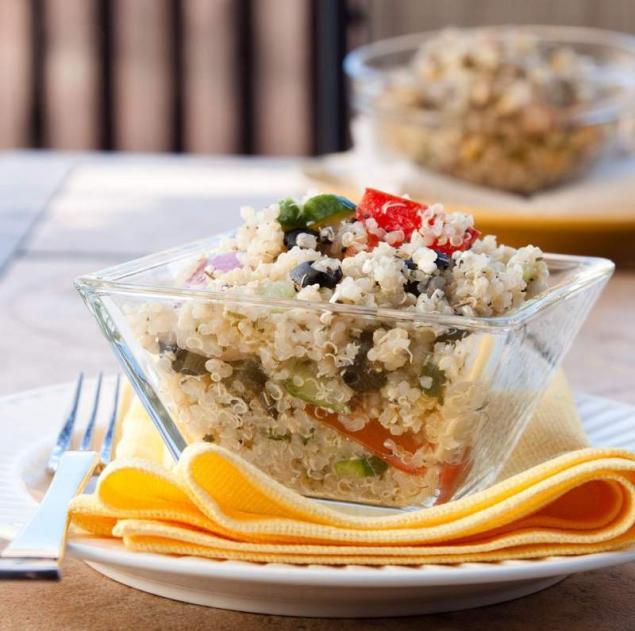
Quinoa with black beans
Soak the beans for 8 hours, change water, boil until tender (1 hour). Drain the water.
Quinoa soak in cold water for 1 hour, drain in a sieve to dry out.
Sweet pepper remove seeds, flesh cut into cubes.
Onion and garlic chop, fry with sweet peppers in oil on medium heat 5 min. Add the beans and quinoa, add the broth, bring to boil, cover, cook 20 – 25 minutes on low heat.
5 minutes prior to readiness to put the corn, cumin, Cayenne and black pepper, salt, chopped cilantro.
This dish can be served hot or cold. Goes well with spicy chicken, avocado, sour cream.
Sorghum. This grain that looks like corn, spread around the world from Equatorial Africa, India and China. In Africa and Asia as a fodder and grain plant grown kind of durra in South Africa the most important is "Kaffir sorghum" – kaffir, in the East it Chinese "kaoliang".
Sorghum from cereals, rich in starch and protein, cook porridge, of flour to bake fresh bread and tortillas. From the stems of sugar sorghum molasses get ("sorghum honey"). Sorghum is used to produce starch, beer, alcoholic drinks and alcohol.
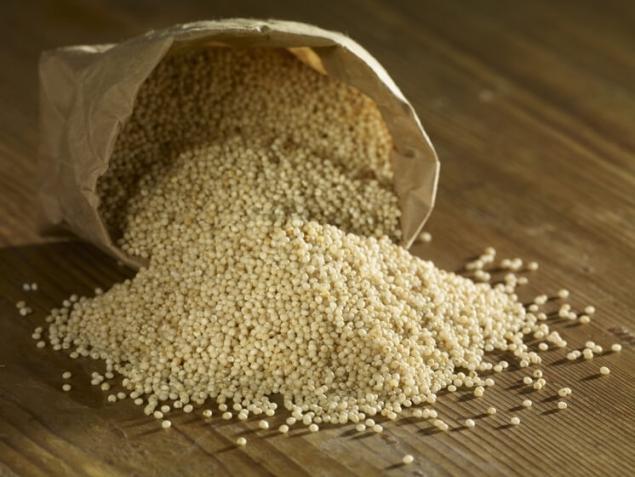
Sago. Initially, the so-called rump of the granular starch extracted from the pith of sago palm. In Russia, where palm trees grow poorly, the word "sago" came to mean similar in appearance, the rump of potato starch, which were cooked porridge. Feature sago is the virtual absence of protein.
Also interesting: 14 useful grains, about which not all know
Cutlets from cauliflower and quinoa
Good recipe – corn bread Cornbread
Knead the batter from flour, milk, buttermilk, beaten eggs, sugar, honey, salt, soda and oil. Put the dough in a greased form and bake for 40 – 50 minutes at 200 degrees.published
Author: Dr. Ernest Artemov
P. S. And remember, only by changing their consumption — together we change the world! ©
Source: doctorartemov.com/content/krupy-bez-glyutena
The answers in the table and the magazine "Deli" № 2 (73) for February 2008
A doctor's note Artemova E. M.: a categorical ban on these products only applies to celiacs. As for patients with coeliac and just people wanting to lead a healthy and comfortable lifestyle, in cases where the product is over a little gluten for this category of people for example, it is highlighted in green. In addition, patients with celiac disease should take into account the presence of gluten in the germ of corn kernels. This, incidentally, implies the prohibition for these patients, "pshonka" – boiled cobs, whole corn, canned corn, corn flour, non-industrial production. In the industrial production of corn flour from the grain during milling removes the germ!

Not contain gluten (allowed):
- Cereals: rice, buckwheat, corn, millet (millet), Italian millet (millet), sago, sorghum, amaranth, quinoa, montina;
- Root vegetables: potatoes, Yam (sweet potato), tapioca, cassava;
- Legumes: soybeans, peas, beans, lentils, chickpeas, mung beans, etc.;
- All vegetables and fruits;
- Meat, fish, eggs;
- Milk and natural dairy products (kefir, yogurt, fermented baked milk, yogurt, etc.);
- Hard cheese, also made in Russia and Ukraine in violation of the GOST /added powdered gluten – free!/, butter, vegetable oil.

Buckwheat , a close relative of rhubarb and sorrel. This herbaceous plant comes from the mountainous regions of India, Burma and Nepal where he began to cultivate more than four thousand years ago. From India "black rice" came to China, Central Asia, Africa, the Caucasus and Greece. In Kievan Rus it was engaged in breeding of Greek monks. It's probably why she started calling it "Greek" barley. In addition to the common buckwheat there is another wild species of this plant, common in Siberia and the Urals region – Tatar buckwheat (Fagopyrum tataricum). In Ukraine and in the Volga region it is called "Tartar".
In southern Russian, Ukrainian and Western regions of the buckwheat is sometimes called a "drop cap" for the similarity of its seeds with seeds of beech. Boekweite Dutch, German buchweizen buckwheat and English the name also translated as "beech wheat". French (ble sarassin) and Italian (grano saraceno) – Aracinovo grain is most closely related to the dark color of the beans.
Buckwheat porridge with white mushrooms

- 2 cups choice of buckwheat
- 300 g frozen porcini mushrooms
- 2 large bulbs
- 5 tbsp ghee (post – plant) oil
- 1 tsp dried thyme
- Salt to taste
Clean the mushrooms with a brush, not defrosting, pour 1 liter of boiling water, bring to the boil, add salt, cook for 10 minutes. drain in a colander (save the broth), dry.
Lightly fried buckwheat with thyme and salt in 1 tbsp oil, pour the hot broth from the mushrooms, cook under the lid, not stirring, until all the liquid is absorbed, 12 – 15 min.
Wrap the pot in Newspapers and blankets for 15 min.
Onion cut into thin rings and fry in 3 tbsp oil on low heat until Golden brown, 15 min.
In another pan in the remaining oil over high heat, quickly fry the mushrooms. Spread out on warmed plates cereal, sprinkle onions and mushrooms, serve immediately.
Millet (millet) is the oldest cultivated plant known to the Asians and Africans for over 5 thousand years and is still the staple food of one third of the world's population. At the same time in the United States and Western Europe, millet is used mainly as feed for livestock and poultry. But in recent years, in connection with a widespread fascination healthy diet, this rich in protein and carbohydrates grass begins to enter into the daily diet of Europeans and Americans, who call him the Russian word proso.
From millet get several types of cereals: millet-dranec, i.e. whole grains, released from the flower films. This cereal has an intense yellow color, characteristic luster and a bitter taste. Peas (crushed) contains only the grain kernel has been completely cleared. It is lighter than millet-dranec, and not shiny. This millet is better absorbed, cooks faster and is perfect for cereals and casseroles. And finally – millet crushed. This is a byproduct of the processing of the millet, namely, fragmented nucleus.
Millet is boiled as a side dish, stewed with meat, millet flour used to bake bread. Kazakhs love "Nauryz-skin" – Pshenko, fermented in katuke. Ukrainians prefer gruel – liquid millet porridge with bacon, sunflower oil, bacon, onion, garlic, herbs. In the Caucasus until the early twentieth century the main food was a steep millet porridge – "Basta".

Garlic croutons buckwheat porridge
- 2 cups of millet
- 400 ml vegetable broth
- 1 egg
- 1 clove of garlic
- 1 tsp mix of dried Italian herbs (caution against hidden gluten!)
- Pinch of sea salt
- Freshly ground black pepper
Crush the garlic. Millet rinse thoroughly. Broth bring to a boil in a saucepan with a thick bottom. Add all ingredients except eggs and cook, stirring, until the mixture begins to fall from the walls.
Shift it in a round neprikosaemye baking dish with a diameter of 23 cm, spatula and cool.
Cut into triangles. Spread on large baking sheet, brush with scrambled egg and bake under the hot grill until they become Golden and crispy.
Serve hot with a green salad, vegetables, sauteed mushrooms.
Amaranth. Worldwide in warm and temperate areas grows Amarant, or amaranth, is used in ornamental horticulture. And in Central and South America thousands of years diluted his grain (or rather, seed). In pre-Columbian era, amaranth was a staple of the indigenous peoples of Mexico, tons of its tiny seeds annually sent to the capital as a tribute to the Supreme ruler.
In the 1950s, when scientists proved the extraordinary nutritional properties of amaranth, the farmers of the southern, Central and even North America again "started" for forgotten grain.
The protein in amaranth as much as in other cereals. It is very rich in lysine – essential for humans amino acid, is not always found in sufficient quantity.
Yellowish-brown, with a slight peppery taste of amaranth grain are usually cooked as porridge or do them in the flour. Grits seasoned broth served on the side. In Mexico, from the seeds, mixed with honey, make a kind of sweet pop corn and Chile fermented seeds give the "beer" – chichi.

Soup with amaranth
- 70 g of amaranth
- 1,5 l chicken broth
- 2 tomatoes
- 1 potato
- 1 small zucchini
- 100 g of corn
- 1 large onion
- 2 cloves of garlic
- 1 large yellow sweet peppers
- 3 tbsp olive oil
- Large bunch of spinach
- A big bunch of parsley
Amaranth cover with cold water, bring to boil, boil 10 minutes, drain in a sieve.
The onion and crush the garlic. Peel the potatoes peeled, the tomatoes and peppers from seeds, cut into cubes.
Fry in oil onion and garlic, 5 min, pour the broth, add the vegetables and cook under the lid 5 min. Add the amaranth and cook for 8 min. Add chopped parsley and spinach, cook for 1 min.
Quinoa. In the Andes, quinoa (quinoa, quinoa, rice quinoa) has been prized since ancient times, Indians considered it a sacred grain, "mother of all grains". This is the highest cereal crop in South America still plays a very important role in the cuisine of Peru, Chile, Bolivia, Ecuador, Colombia.
From nutritious black, white or red flat seeds quinoa which contain large amounts of vitamins, protein and amino acids, which are flour and cereals. They make cakes, cook porridge and even brew beer.
Pre-grain is well washed and soaked, since its surface layer contains bitter substances. Grains sold in supermarkets, have already passed this procedure.
The grain quinoa is cooked just like rice. In finished form they become translucent. They can be used as an additive to soups and salads, a garnish for hot dishes, for stuffing vegetables. Quinoa in the US is preparing pasta.

Quinoa with black beans
- 150 g quinoa
- 150 g of frozen corn
- 100 g of black beans
- 1 red sweet pepper
- 1 onion
- 350 ml vegetable broth
- 3 cloves of garlic
- 1 tbsp corn oil
- Small bunch fresh cilantro
- Pinch of cumin
- Pinch of Cayenne pepper
- Salt
- Black pepper
Soak the beans for 8 hours, change water, boil until tender (1 hour). Drain the water.
Quinoa soak in cold water for 1 hour, drain in a sieve to dry out.
Sweet pepper remove seeds, flesh cut into cubes.
Onion and garlic chop, fry with sweet peppers in oil on medium heat 5 min. Add the beans and quinoa, add the broth, bring to boil, cover, cook 20 – 25 minutes on low heat.
5 minutes prior to readiness to put the corn, cumin, Cayenne and black pepper, salt, chopped cilantro.
This dish can be served hot or cold. Goes well with spicy chicken, avocado, sour cream.
Sorghum. This grain that looks like corn, spread around the world from Equatorial Africa, India and China. In Africa and Asia as a fodder and grain plant grown kind of durra in South Africa the most important is "Kaffir sorghum" – kaffir, in the East it Chinese "kaoliang".
Sorghum from cereals, rich in starch and protein, cook porridge, of flour to bake fresh bread and tortillas. From the stems of sugar sorghum molasses get ("sorghum honey"). Sorghum is used to produce starch, beer, alcoholic drinks and alcohol.

Sago. Initially, the so-called rump of the granular starch extracted from the pith of sago palm. In Russia, where palm trees grow poorly, the word "sago" came to mean similar in appearance, the rump of potato starch, which were cooked porridge. Feature sago is the virtual absence of protein.
Also interesting: 14 useful grains, about which not all know
Cutlets from cauliflower and quinoa
Good recipe – corn bread Cornbread
- 2 cups corn flour
- 1 Cup milk
- 1 Cup of yogurt
- 1 egg
- ½ Cup sugar
- ½ Cup honey
- 1 tbsp. salt
- 1 tbsp of baking soda
- 1 tbsp. butter
Knead the batter from flour, milk, buttermilk, beaten eggs, sugar, honey, salt, soda and oil. Put the dough in a greased form and bake for 40 – 50 minutes at 200 degrees.published
Author: Dr. Ernest Artemov
P. S. And remember, only by changing their consumption — together we change the world! ©
Source: doctorartemov.com/content/krupy-bez-glyutena
Tags
See also
Raw Food: simple recipes for recovery
Flour gluten free, healthy substitute for wheat flour
Buckwheat pancakes gluten free
Easy rhubarb tart: gluten-free and sugar-free!
Delicious buckwheat pancakes gluten free
How to cook the most delicious in the world chilli oil
Diet is the principle food of Tibetan monks
Season the eggplant open 3 simple recipe for making "little blue".
Lost recipes of the ancestors: On the forest milk and wetland bread
What gluten free flour is best for baking

















